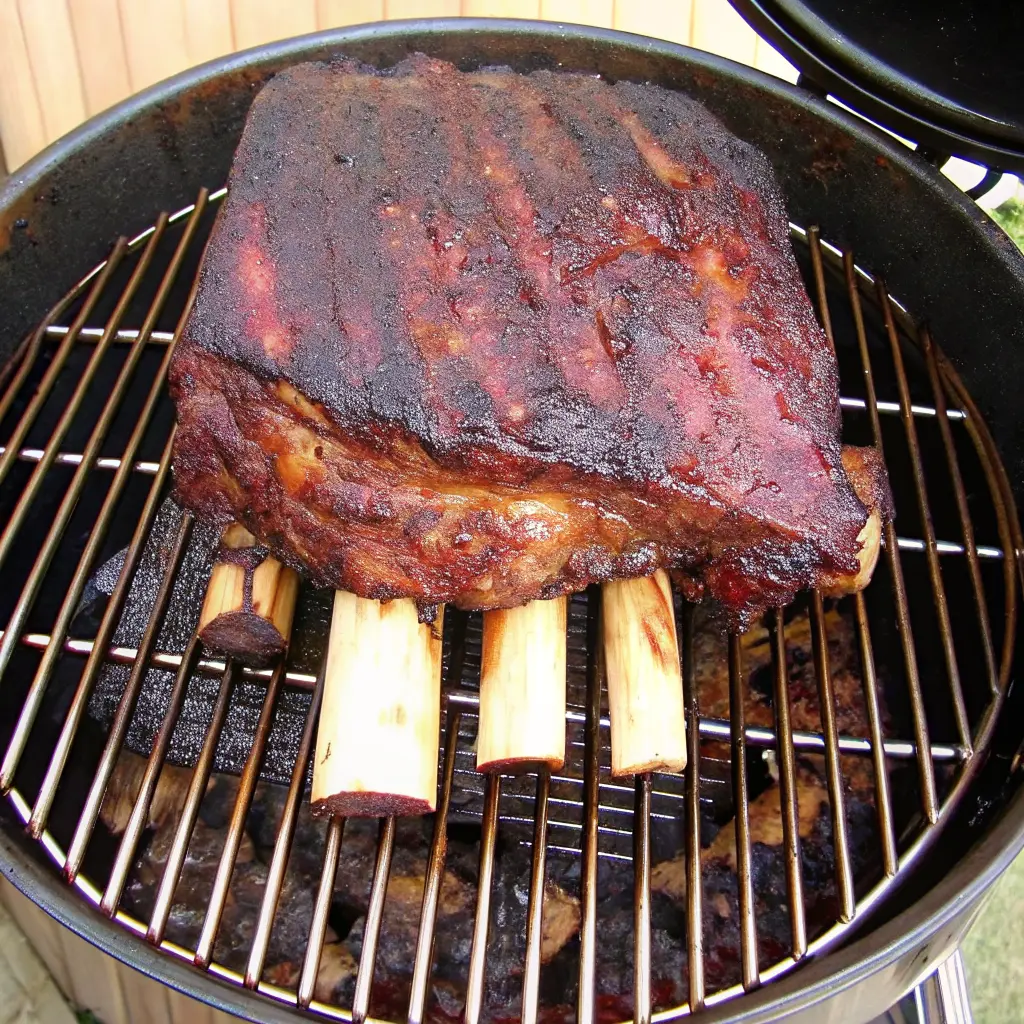Beef plate ribs are the crown jewels of slow-cooked barbecue. Known for their thick, juicy meat and deep marbling, beef plate ribs deliver unmatched flavor and tenderness that meat lovers crave. If you’ve ever wanted to cook ribs that fall off the bone and burst with smoky richness, beef plate ribs should be at the top of your grilling or roasting list.
These ribs are cut from the lower portion of the cow’s ribcage and offer a hearty, beef-forward taste that stands out in any dish. Whether you smoke them, roast them, or grill them over open flames, beef plate ribs absorb spices beautifully and finish with that perfect bark crust. They’re bold, meaty, and surprisingly simple to prepare—if you know what you’re doing.
In this guide, you’ll learn everything there is to know about beef plate ribs, from selecting the best rack at the butcher shop to nailing the perfect cook every single time. You’ll also find recipe inspiration, pro tips, side dish ideas, and a complete breakdown of what makes this beef cut a true BBQ classic.
Looking for a crowd-pleasing side for your ribs? Check out Sausage and Sweet Potato Sheet Pan Dinner – The Best One-Pan Meal.
Table of Contents
PART 1: Introduction to Beef Plate Ribs
What Are Beef Plate Ribs?
Beef plate ribs are a thick, meaty cut taken from the short plate section of the cow, located near the belly. These ribs include bones six through nine and are often called “short plate ribs” due to their location. Compared to back ribs, beef plate ribs have significantly more meat and fat content, making them ideal for slow cooking methods like smoking or oven roasting.
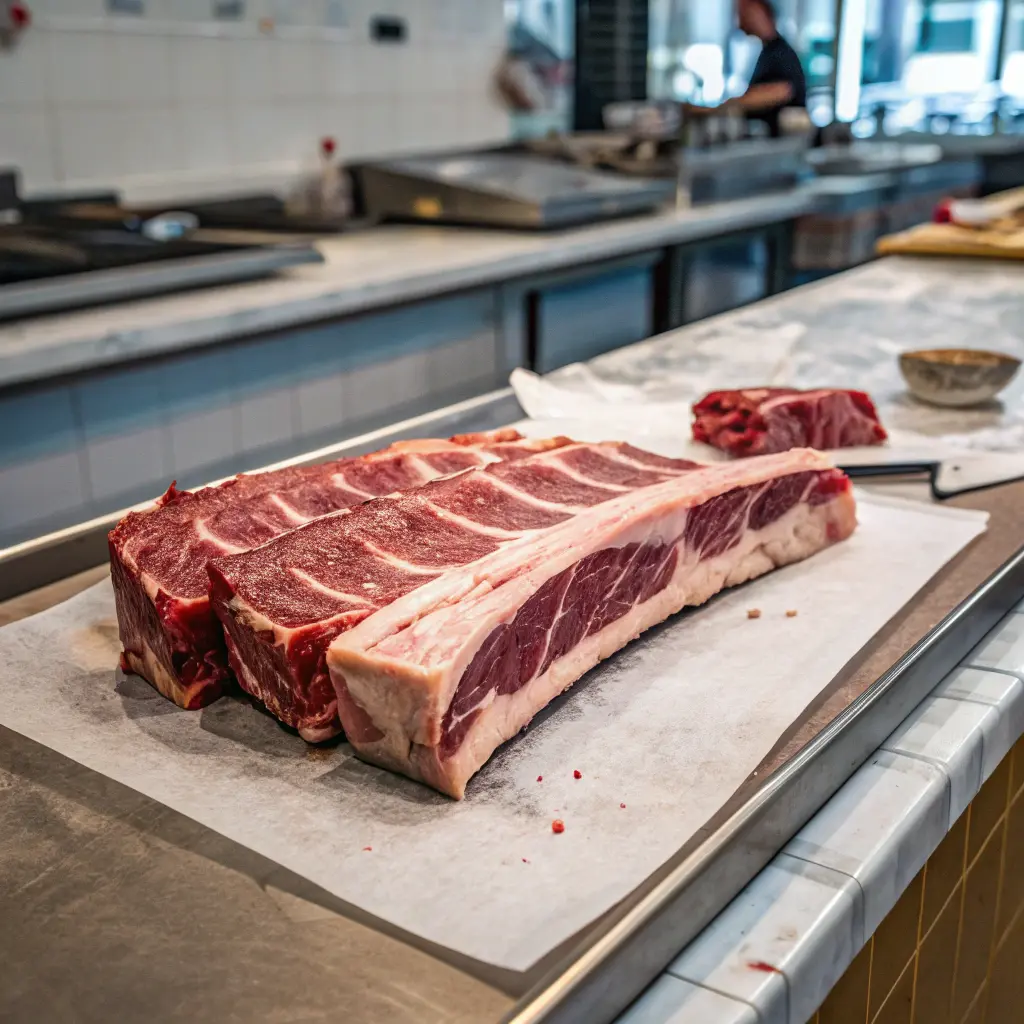
What sets beef plate ribs apart is their dense marbling and large bone size. Each rib can hold a hefty portion of meat, sometimes over an inch thick, with flavorful fat layers that render during cooking. This creates a juicy, tender bite that’s hard to beat. They’re often the go-to cut for BBQ enthusiasts and pitmasters looking for authentic, smoky beef flavor.
Want an easy skillet idea to go with your plate ribs? Don’t miss our Cheesy Smoked Sausage and Potatoes Skillet.
Why These Ribs Are a Cut Above the Rest
There’s a reason beef plate ribs are referred to as “brisket on a stick.” With rich, beefy flavor and melt-in-your-mouth texture, they offer the best of both worlds: bold taste and tender bite. Because of their size and fat composition, beef plate ribs can be cooked low and slow for several hours without drying out—resulting in a juicy, pull-apart finish.
This cut is also highly versatile. You can rub them with just salt and pepper for a Texas-style finish, or slather them in bold BBQ sauces and dry rubs for maximum flavor. They’re perfect for family cookouts, game day feasts, or holiday spreads where you want to impress without spending hours in the kitchen.
PART 2: Understanding the Cut
Where Beef Plate Ribs Come From on the Cow
Beef plate ribs are sourced from the short plate section of the cow, which lies directly below the rib primal and in front of the flank. Specifically, these ribs are taken from bones six through nine—making them larger and meatier than many other rib cuts. When you hold a slab of beef plate ribs, it’s easy to see why pitmasters love them: they’re thick, dense, and full of connective tissue that breaks down beautifully during long, slow cooks.
Unlike beef back ribs, which come from the upper rib section after the ribeye has been removed, beef plate ribs contain far more meat on top of the bone. That extra layer of meat and fat results in a juicier, more flavorful experience. It’s the kind of cut that transforms into a smoky, savory masterpiece after hours in the smoker or oven.
Discover great ideas like How to Cook Frozen Biscuits in Air Fryer if you’re planning easy sides while your beef plate ribs cook low and slow.
Plate Ribs vs. Other Beef Ribs: Key Differences
When comparing beef plate ribs to other rib types like back ribs or chuck short ribs, the distinctions are all about size, fat content, and cooking method. Plate ribs are generally thicker and heavier, often referred to as “dinosaur ribs” due to their massive appearance. Their high fat-to-meat ratio makes them ideal for smoking because the fat renders down slowly, keeping the meat moist and flavorful.
In contrast, beef back ribs are leaner and cook faster but don’t offer the same bold beefiness that beef plate ribs bring to the table. Short ribs, which are cut across the bone rather than with it, are better for braising but don’t match the smoky appeal of a well-cooked rack of plate ribs.
So if you’re after meat that’s deeply flavorful, fall-off-the-bone tender, and visually impressive, beef plate ribs are the clear winner. They require more time and care, but the results are well worth the effort.
PART 3: Prepping Beef Plate Ribs Like a Pro
How to Choose the Best Cut at the Butcher
Selecting the right rack of beef plate ribs is the first step toward a mouthwatering meal. When visiting your local butcher, ask specifically for “short plate ribs” or “plate short ribs” to avoid confusion with back or chuck ribs. You want a rack where the bones are large, flat, and uniform, with at least an inch of meat sitting on top.
Look for beef plate ribs that have consistent marbling throughout the meat. The fat should be creamy white, not yellow, and there should be no excessive trimming from the top. The best racks are untrimmed and come in slabs of 3–4 ribs, sometimes labeled as a “3-bone rack.” These deliver the most meat and the best results on the grill or in the oven.
If you’re buying pre-packaged, check the label for keywords like “plate short ribs” or “ribs 6–9.” These indicate you’re getting the real deal, not a leaner or thinner cut that won’t hold up to long cooking methods.
Trimming, Marinating, and Seasoning Tips
To make your beef plate ribs cook evenly and taste incredible, some prep work is essential. First, trim away any excess hard fat on the surface, but leave the softer marbled fat in place. This will render during cooking and add moisture. Then, flip the rack and decide if you want to remove the silver skin (the membrane on the bone side). Some prefer to leave it on for structure, while others remove it for a softer bite.
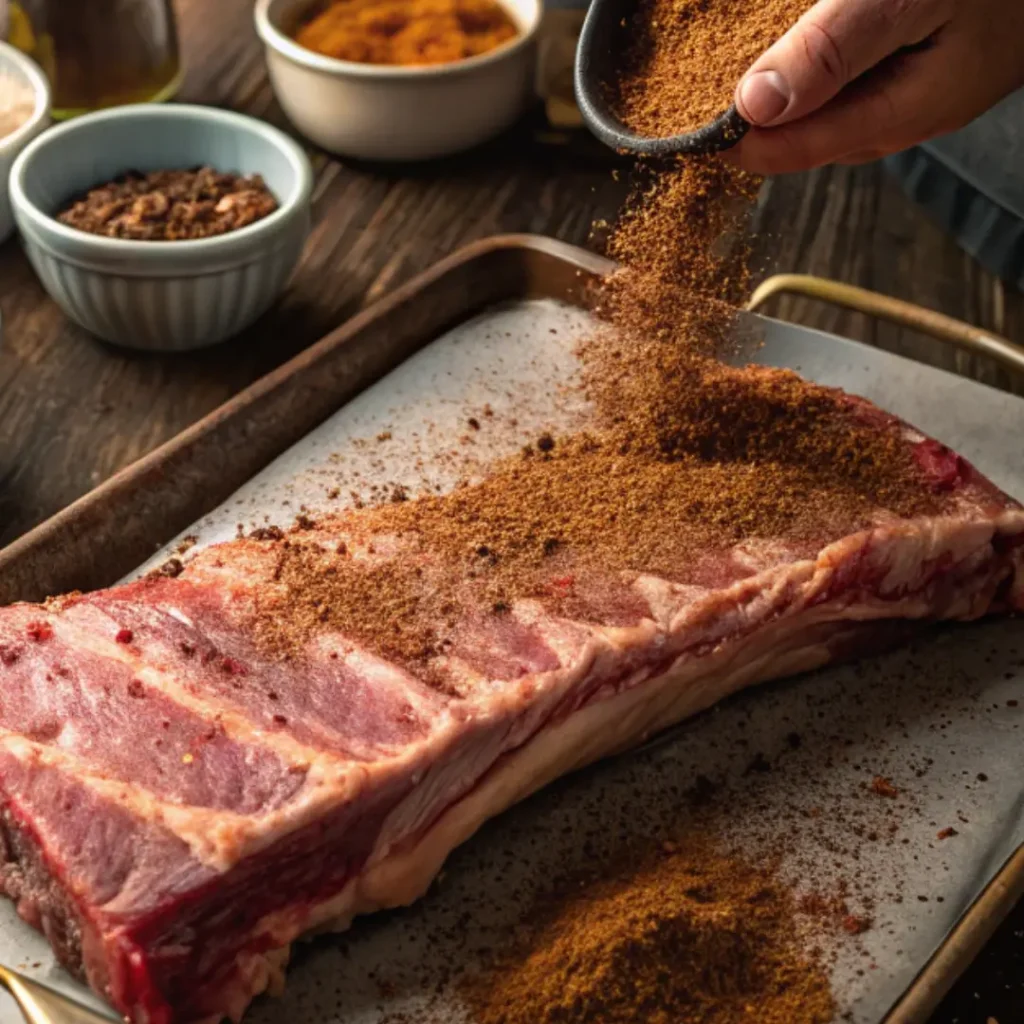
Seasoning is where your creativity can shine. While many pitmasters swear by a simple salt and pepper rub (called the “Dalmatian rub”), you can spice things up with garlic powder, smoked paprika, onion powder, and a touch of cayenne. Dry rubs work best for smoked or grilled beef plate ribs, but if you’re roasting, a wet marinade can boost flavor even more.
Let the ribs rest at room temperature for 30–45 minutes before cooking to ensure an even cook. This lets the seasoning penetrate deeper and gives the meat a chance to warm slightly, which helps with browning.
Don’t miss our juicy oven-baked comfort idea: How to Cook Frozen Biscuits in Air Fryer. It’s a perfect pairing for smoky beef ribs.
PART 4: Cooking Methods for Beef Plate Ribs
Slow Roasting in the Oven
When you don’t have a smoker or just want to keep things simple, roasting beef plate ribs in the oven is a surefire way to get juicy, tender results. This method is all about patience—low and slow is the name of the game. Start by preheating your oven to 275°F, and place your seasoned beef plate ribs on a wire rack inside a roasting pan. This helps the heat circulate evenly around the meat.
For added moisture, add a splash of broth or water to the pan and cover it tightly with foil. Cook the ribs for about 3 to 4 hours, then remove the foil and increase the heat to 375°F for the last 30 minutes to develop that delicious crust. You’ll know they’re done when a skewer slides through the meat with zero resistance.
Oven roasting is perfect when you want a set-it-and-forget-it style dinner. The ribs come out tender and flavorful without needing constant attention. Just make sure to let them rest before slicing to keep all those juices inside.
Grilling and Smoking Techniques
For smoky, fall-off-the-bone perfection, smoking beef plate ribs is the gold standard. This method develops that dark, bark-like crust on the outside while keeping the inside tender and juicy. Use a smoker set between 225°F and 250°F, and cook the ribs bone-side down for 6 to 8 hours. You can use hickory, oak, or mesquite wood to add bold, earthy flavor to your beef plate ribs.
Be generous with your dry rub, and spritz the ribs every hour with apple juice or beef broth to prevent drying out. A good bark takes time, so don’t rush the process. You’ll be rewarded with meat so tender it slides off the bone with a gentle tug.
Grilling is another solid option if you don’t have a smoker. Use indirect heat and keep the temperature steady. Wrap the ribs in foil halfway through grilling and finish with a quick sear over direct heat for that smoky charred edge.
Looking for inspiration? Try Cheesy Smoked Sausage and Potatoes Skillet for a smoky side dish to pair with grilled ribs.
PART 5: Oven-Baked Beef Plate Ribs Recipe
Step-by-Step Instructions for Tender Ribs
Making perfect beef plate ribs in the oven is easier than you think—especially when you follow this simple, no-fuss recipe. This method creates fall-off-the-bone texture and deep, beefy flavor right in your kitchen. All you need is time, seasoning, and a few basic tools.
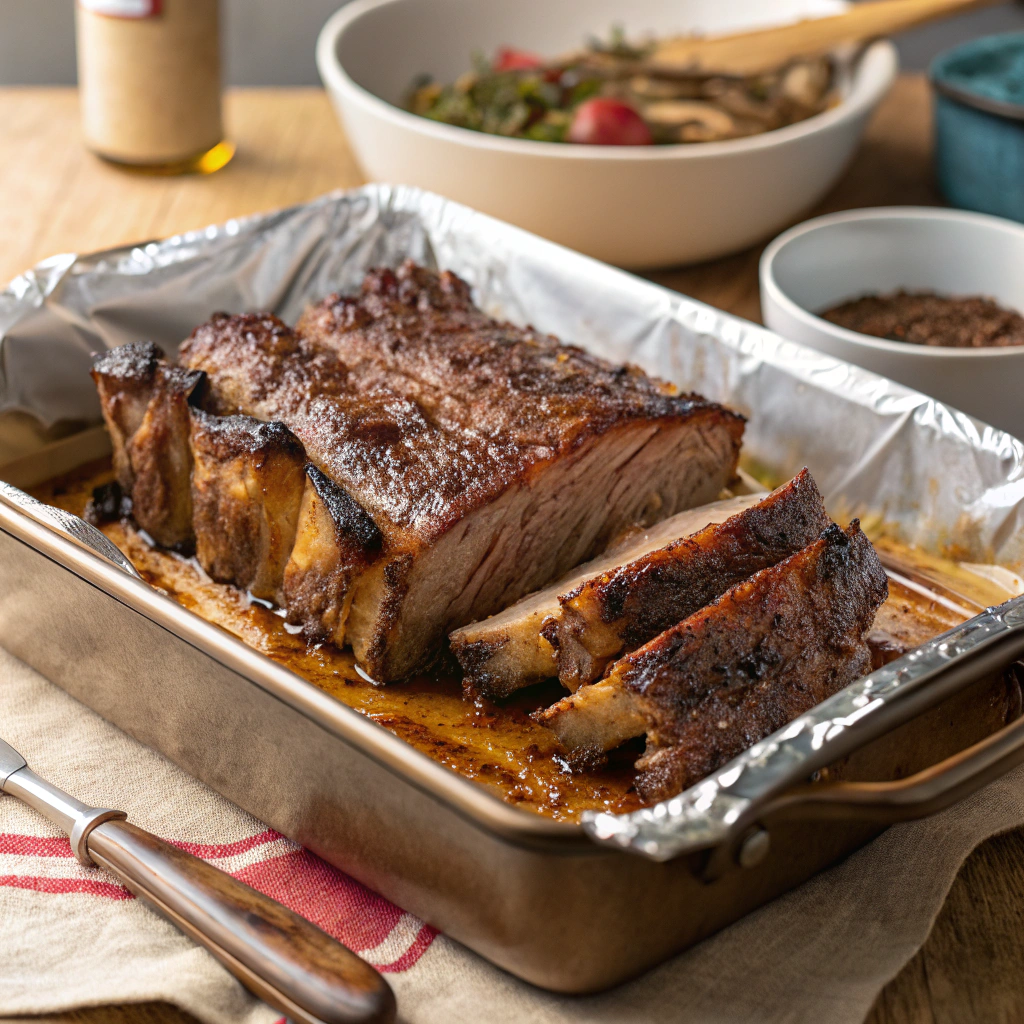
Here’s how to make juicy, oven-baked beef plate ribs that taste like they came off a smoker:
Ingredients:
- 1 full rack (3-4 bones) beef plate ribs
- 2 tbsp kosher salt
- 2 tbsp coarse black pepper
- 1 tsp garlic powder
- 1 tsp smoked paprika
- ½ tsp cayenne (optional)
- 1 cup beef broth or water (for moisture)
Instructions:
- Preheat oven to 275°F.
- Prepare your ribs. Pat the beef plate ribs dry with paper towels and trim off excess hard fat if needed. Remove silver skin from bone-side if desired.
- Mix the rub. Combine all dry ingredients in a bowl.
- Season the ribs. Apply rub generously all over the meat side and lightly on the bone side. Let it sit at room temperature for 30–45 minutes.
- Set up the pan. Place a wire rack in a roasting pan. Add broth or water to the bottom of the pan (just enough to cover it) to create steam while cooking.
- Bake low and slow. Lay the ribs bone-side down on the rack. Cover tightly with foil. Bake for 3.5 to 4 hours until fork-tender.
- Uncover and crisp. Remove the foil and increase heat to 375°F. Cook uncovered for another 30–40 minutes to develop a crust.
- Rest before serving. Let the beef plate ribs rest at least 15 minutes before slicing. This helps lock in moisture.
Optional Glaze (for a shiny finish):
Mix ½ cup BBQ sauce with 2 tbsp apple cider vinegar and brush on during the final 20 minutes of uncovered cooking.
Don’t miss our go-to comfort side: How to Cook Frozen Biscuits in Air Fryer. They’re crispy, fluffy, and amazing with juicy ribs.
Common Mistakes to Avoid While Baking
Even though oven-baking is straightforward, some missteps can ruin your beef plate ribs. Avoid these common errors:
- Skipping the rest time. Slicing into hot ribs lets juices run out too early. Always rest your beef plate ribs after cooking.
- Not using foil. Covering the ribs helps trap steam and break down connective tissue. Skipping this step results in dry, tough meat.
- Over-seasoning. These ribs are rich and fatty—keep it simple. Let the meat speak for itself.
- Cooking at too high a temp. Low and slow is crucial. High heat will dry out the fat before it can render.
By steering clear of these slip-ups, you’re guaranteed tender ribs every time.
PART 6: Grilled and Smoked Beef Plate Ribs
How to Smoke Ribs for Maximum Flavor
Smoking beef plate ribs is where true barbecue magic happens. Known as the “brisket on a stick,” this cut transforms beautifully when smoked low and slow, absorbing deep wood flavor while developing a perfect bark. To start, fire up your smoker to a steady 225°F and choose your wood wisely—oak, hickory, and mesquite all pair well with the bold flavor of beef plate ribs.
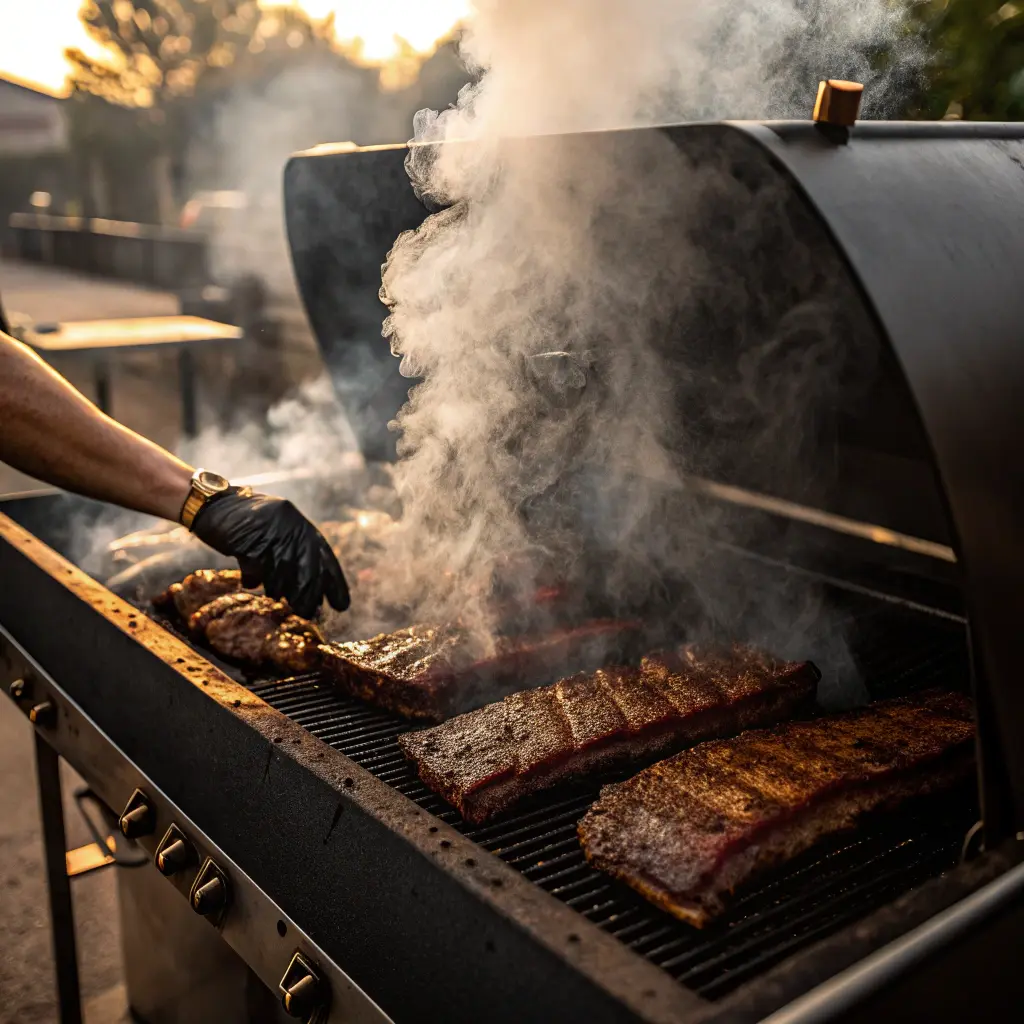
Before placing the ribs on the smoker, coat them with your preferred dry rub. A simple salt and pepper base works well for a traditional Texas-style taste, but you can also add layers like garlic powder or chili flakes for extra depth. Once seasoned, place the ribs bone-side down directly on the smoker grates.
Plan for a 6 to 8 hour smoke, depending on thickness. Spritz the ribs every hour with a mix of apple juice and beef broth to keep the surface moist. After about 5 hours, wrap the ribs tightly in butcher paper or foil and return them to the smoker for the final stretch. They’re done when a thermometer inserted into the meat reads around 200–203°F and a probe slides in like butter.
Rest the beef plate ribs for at least 30 minutes after removing from the smoker—this lets the juices redistribute and keeps every bite tender and flavorful.
Looking for inspiration? Try Cheesy Smoked Sausage and Potatoes Skillet as a savory side dish to complement your smoky ribs.
Grilling Tips and Time Guidelines
No smoker? No problem. Grilling beef plate ribs over indirect heat is a great alternative that delivers char, crust, and plenty of juicy flavor. The key is maintaining a steady medium-low grill temp (around 300°F) and keeping the ribs off direct flame.
Set your grill for two-zone cooking. Place the beef plate ribs on the cooler side of the grill, bone-side down, and close the lid. Let them cook slowly for about 3 hours, checking occasionally to ensure even cooking. Wrapping the ribs in foil for the final hour will help steam them slightly and lock in moisture.
In the last 10–15 minutes, finish the ribs directly over the heat source to get that rich, caramelized crust. Just don’t walk away—because of the fat content, flare-ups can happen fast. Let them rest briefly before slicing into each thick, meaty rib.
Grilled beef plate ribs are great for backyard cookouts or quick summer dinners. They carry deep beef flavor with a slightly smoky edge, and they look downright stunning on the plate.
PART 7: Pairing and Serving Suggestions
Perfect Side Dishes for Beef Plate Ribs
When you serve up a slab of beef plate ribs, you want sides that complement their rich, smoky flavor without overpowering them. Because beef plate ribs are bold and beefy, pair them with bright, fresh, or creamy sides that create balance on the plate.
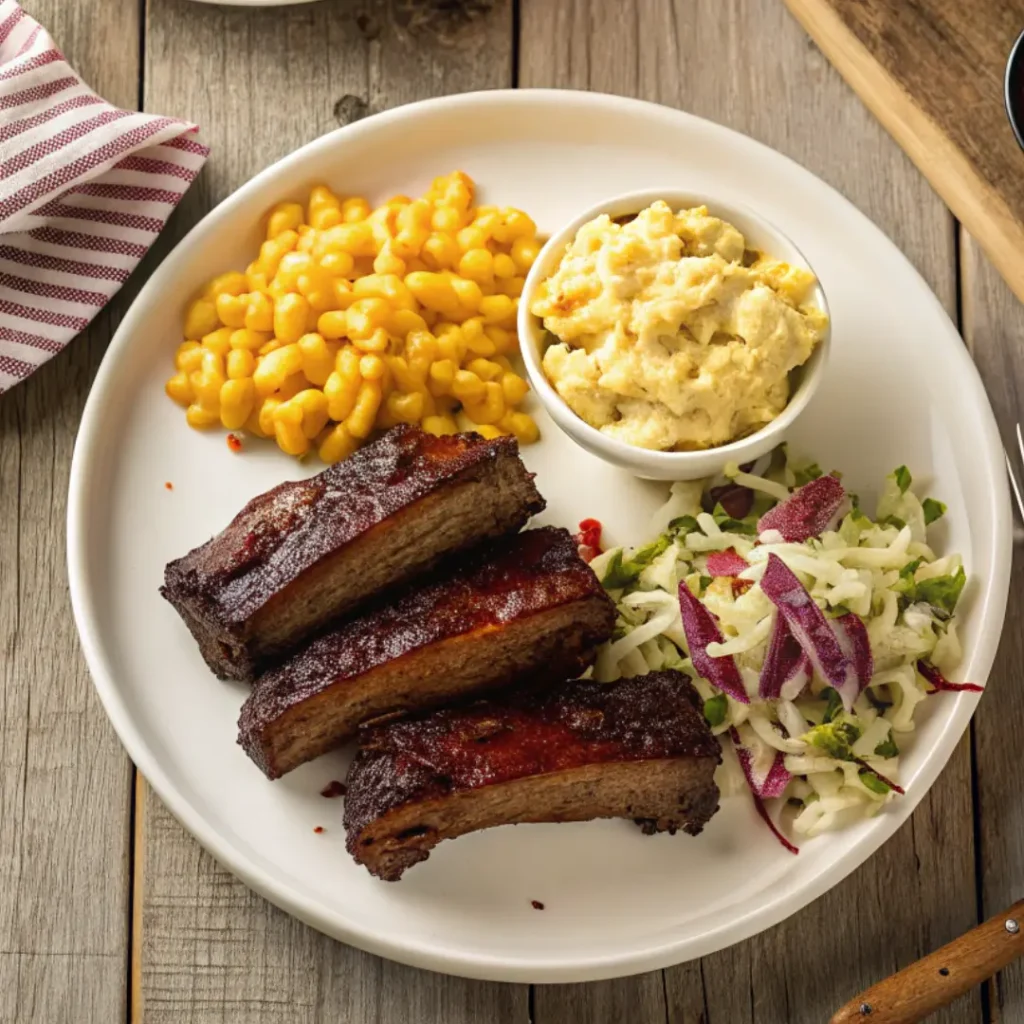
Here are some standout options:
- Creamy coleslaw: Its tanginess cuts through the richness of the ribs.
- Grilled corn on the cob: Charred and buttery, it’s a backyard BBQ classic.
- Baked mac and cheese: Comfort food at its finest, and it holds up to the meat’s intensity.
- Roasted garlic mashed potatoes: Smooth, savory, and indulgent.
- Pickled red onions or jalapeños: Add a punch of acid to refresh your palate.
- Texas-style pinto beans or BBQ baked beans: Smoky and slightly sweet, they echo the flavor of the ribs.
When planning your menu, think contrast: pair the deep, meaty flavor of beef plate ribs with light, crunchy textures and zesty bites for a perfectly rounded meal.
Learn more about crafting a full BBQ spread with sides in our article on Sausage and Sweet Potato Sheet Pan Dinner, which can be adapted for rib nights too.
Sauces and Marinades That Complement Ribs
While beef plate ribs don’t necessarily need sauce thanks to their natural flavor, the right glaze or dip can elevate your rib game even further. When it comes to sauces, the best ones either highlight the smokiness or contrast the richness.
Here are some crowd-pleasing choices:
- Classic BBQ Sauce: Sweet, tangy, and perfect for brushing on during the last 15 minutes of cook time.
- Chimichurri: Bright, herbal, and slightly spicy—great for grilled beef plate ribs.
- Spicy mustard glaze: Adds a bold twist and cuts through the fat.
- Bourbon or coffee glaze: Deep and complex, these work well for oven-baked or smoked ribs.
If you’re planning ahead, consider marinating your beef plate ribs overnight in a mixture of soy sauce, Worcestershire, brown sugar, garlic, and chili for bold flavor from the inside out.
And don’t forget to serve extra sauce on the side. Some folks love to dip every bite.
PART 8: Expert Tips for Storage and Reheating
How to Store Leftover Ribs
If you’ve got extra beef plate ribs (lucky you), storing them the right way can make all the difference. These ribs hold up well when properly cooled and stored, maintaining their juicy texture and bold flavor even days later. The key is to wrap them tight and keep air out.
Once your beef plate ribs have cooled to room temperature, wrap each piece tightly in foil or butcher paper. Then, place the wrapped ribs in an airtight container or a heavy-duty freezer bag. Store them in the refrigerator for up to 4 days. If you’re planning on saving them longer, freeze them instead—they’ll keep for about 2 to 3 months.
For freezing, label each package with the date and type of rib. When stored this way, the flavor stays rich, and the meat remains tender even after reheating.
Best Ways to Reheat Without Drying Out
Reheating beef plate ribs without drying them out is all about moisture and method. You want to bring them back to life—not ruin that beautiful bark or tender center.
Here are three top methods:
1. Oven (Best for Moisture Retention):
- Preheat your oven to 275°F.
- Place the beef plate ribs in a baking dish with a few tablespoons of beef broth or water.
- Cover tightly with foil and heat for 20–30 minutes until warmed through.
2. Sous Vide (For Texture Preservation):
- Place ribs (vacuum-sealed or in a zip bag) into a 150°F water bath for 45–60 minutes.
- This low, slow heat warms ribs evenly without drying them out.
3. Microwave (Quick but Watch the Timing):
- Wrap ribs in a damp paper towel and microwave on medium heat for 2–3 minutes.
- Flip halfway through and watch closely to avoid overcooking.
Whichever method you choose, avoid high direct heat—that’s what makes reheated beef plate ribs tough and chewy. Low and gentle is the name of the game.
PART 9: FAQ About Beef Plate Ribs
What are beef plate ribs?
Beef plate ribs are a thick, meaty cut from the short plate section of the cow, located near the belly between the brisket and flank. Known for their rich marbling and bold beef flavor, beef plate ribs are commonly used in barbecue because they stay juicy and tender during long, slow cooking. Each rib is large, with a generous layer of meat over the bone, making them a favorite among pitmasters for smoking and roasting.
What’s the difference between beef back ribs and plate ribs?
The key difference is the amount of meat and where the cut comes from. Beef plate ribs are taken from the lower rib cage (ribs 6–9), offering thick meat on top of the bone and more intramuscular fat. In contrast, beef back ribs come from the upper portion, near the ribeye, and are typically leaner with less meat on top. If you’re looking for ribs to smoke low and slow, beef plate ribs are the better choice for both texture and flavor.
What is another name for beef ribs?
Another name for beef plate ribs is “short plate ribs” or sometimes simply “plate short ribs.” In butcher shops, they might also be labeled as “dino ribs” due to their large size. While “beef ribs” can refer to several different cuts—including back ribs and chuck short ribs—it’s important to ask specifically for plate ribs if you want that thick, meaty barbecue style.
What is the difference between beef ribs and short plate ribs?
“Beef ribs” is a broad term that includes multiple types, while “short plate ribs” specifically refers to the cut taken from the lower rib cage. Beef plate ribs, or short plate ribs, are larger and have more marbling than chuck short ribs or back ribs. If you’re after that fall-off-the-bone tenderness and deep flavor, short plate ribs (a type of beef plate ribs) are the premium choice.
Conclusion: Time to Master Beef Plate Ribs at Home
By now, you’ve got everything you need to make beef plate ribs your signature dish—from choosing the perfect cut and prepping it like a pitmaster to slow-roasting or smoking it to perfection. Whether you’re hosting a backyard cookout or craving a weekend comfort meal, beef plate ribs deliver rich, smoky flavor with a melt-in-your-mouth finish that’s hard to beat.
So fire up your oven or smoker, prep those ribs, and let the magic happen. Don’t forget to experiment with seasonings, sauces, and creative sides to make your rib dinners even more unforgettable.
Looking for inspiration? Try something different with our How to Cook Frozen Biscuits in Air Fryer—a fun and flaky side that pairs beautifully with saucy beef ribs.

